Ryan Hall's Blog, page 249
June 2, 2016
A Run in Boston With Meb Keflezighi
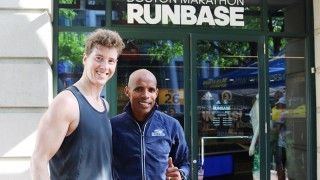
Exercise scientist Jeremy Steeves with Meb Keflezighi in Boston on Global Running Day (June 1) in 2016 (Photo: Chris Lotsbom for Race Results Weekly)
(c) 2016 Race Results Weekly, all rights reserved. Used with permission.
BOSTON — Steps from where he achieved perhaps his greatest career accomplishment in winning the 2014 Boston Marathon, Meb Keflezighi paused for a moment here on Global Running Day on Wednesday. In town to speak at an American College of Sports Medicine conference, Keflezighi thought it would be fitting to join those who supported him most for a morning run along the Charles River, starting and finishing at Boston Marathon adidas RunBase on Boylston Street, steps from the marathon’s finish line.
To Keflezighi, there wouldn’t be any other place in the world that could match the memories and enthusiasm of the streets—and paths—of Boston on Global Running Day. Thousands took to routes along the Charles River Esplanade throughout the day, running from dawn to dusk.
“Most definitely, this was the most memorable victory ever in my career. To be here on Global Running Day and run with people—it’s always amazing. I love seeing people exercise especially with running,” Keflezighi told Race Results Weekly, moments after completing 11 miles at roughly a 6:35/mile clip. “To come here and have people to run with, it was so nice… It was a great day out there.”
As chance had it, Keflezighi stopped in Boston on his way home from Eritrea, where he had been for nine days. Invited to celebrate the nation’s 25th anniversary of independence, Keflezighi got to visit many family members and the nation’s leaders back in his native country. Training at altitude while there, he saw elites Zersenay Tadese, Yonas Kifle, and Ghirmay Ghebreslassie.
But on Global Running Day, Keflezighi made sure to record some miles with Bostonians. Joining members of the Boston Athletic Association staff, B.A.A. High Performance coach Terrence Mahon, and other local runners, Keflezighi hit the roads with a pep in his step (despite it being only 7 a.m. and coming off of harsh jet lag).
“People were honking, people were saying ‘Go Meb!’ It’s humbling just to be here,” said Keflezighi, before noting a special story that hit close to his heart.
Jeremy Steeves, an exercise science professor from Maryville College in Tennessee who was in town for the College of Sports Medicine Conference bumped into Keflezighi in a hotel elevator late Tuesday night. A runner himself, Steeves asked if there was any way he could complete a couple miles with Meb over the next few days. He even said he’d be willing to get up anytime—as early as 4:30 a.m.—to run together.
Both Keflezighi and Steeves took to the streets of Boston together with Mahon for 11 miles, personifying what Global Running Day is all about: bringing people together from all walks of life through the sport, while promoting physical fitness and well-being at the same time.
“To have people exercising, to have people moving, I just love to get a sweat personally. That, for me, sweating is a good thing for me, whether your running 11 miles or one mile. I got to do that and it’s just very fun to be here in Boston for this special day,” said Keflezighi. “To see old friends like Terrence and Jen [Rhines, a three-time Olympian] and Tom [Grilk, Executive Director of the B.A.A.] and you, and new friends like Jeremy, it’s very special.”
Along the Charles River, one by one runners recognized they were in the midst of a Boston Marathon—and TCS New York City Marathon—champion. Some circled back and joined the growing group, while others simply did a double take and continued on. One man sprinted to join the pack.
“I always run alone at this time, and didn’t want to miss a chance to run near Meb,” he said mid-stride.
Gradually cranking up the pace, Keflezighi and Mahon seemed to rule the soft surface paths along Boston’s most iconic river. In the early miles, conversations drifted from the 2016 U.S. Olympic Trials in Los Angeles (“It was HOT, but Rio won’t be nearly that bad.”) to the Kenyan and Ethiopian Olympic Marathon teams selection (“I’ll be studying their teams closely”); then to family, friends, and the last Olympiad in London. Keflezighi chuckled when this writer recalled him saying in the mixed zone that the 2012 Olympic Marathon would be his last, plain and simple. “It’s funny how things happen and change. It’s very fulfilling,” said Keflezighi.
But towards the middle miles, conversation faded and the group behind Mahon and Keflezighi simply ran in silence. Taking in the moment, runners from across the nation—from Tennessee to Wisconsin and beyond—enjoyed running in the wake of an American icon. Not only did Meb win the 2014 Boston Marathon; he helped heal a state and country a year after the tragic acts on Patriots’ Day, and even further has motivated generations of runners to get the best out of themselves.
Upon his return to RunBase, Keflezighi observed the numerous exhibits of memorabilia, including one that featured an autographed shirt and medal from his 2014 run. After a quick stretch and cool-down, when nearly all the morning’s runners had gone their separate ways, Keflezighi paused to chat with staff and fans.
Even at 41, Keflezighi enjoys lacing up his shoes and getting out the door each and every day. When he can share the joy of running with others, it makes him realize how unique our sport really is. Running helped create countless opportunities and friendships for Keflezighi over the years, and he hopes that all runners can experience the same benefits as he has since taking up the sport as a child.
While he said training for Rio de Janeiro is going well and there’s a lot of work still to be done, the 2004 Olympic silver medalist was quick to savor the moment back here in Boston.
“To be on Hereford and Boylston Street, a magic moment of my career,” he began before a long pause, looking out to where the 26-mile mark would stand on Marathon Monday. “You know, I was here to be a runner. That was a solidification, that was one of the reasons I was here, to be a runner. That’s one of the reasons why I am on this earth—to run. To be on Boylston and Hereford again, it’s pretty amazing. It’s very hard to put into words.”
PHOTO: Exercise scientist Jeremy Steeves with Olympic silver medalist Meb Keflezighi in Boston on Global Running Day (June 1) in 2016 (photo by Chris Lotsbom for Race Results Weekly)
The post A Run in Boston With Meb Keflezighi appeared first on Competitor.com.
13 Instagram Accounts Runners Need to Follow
Running is social. Whether it’s capturing nightly urban group runs with local street art as a backdrop or curating images of powerful female runners around the world, these Instagram accounts connect you to the ever-expanding and diverse community of running. Hence, we selected the most inspiring, unique, popular, interesting and useful Instas about running out there for your endless scrolling pleasure.
Photo Gallery
1 of {count}
Back to Start
View Larger Image
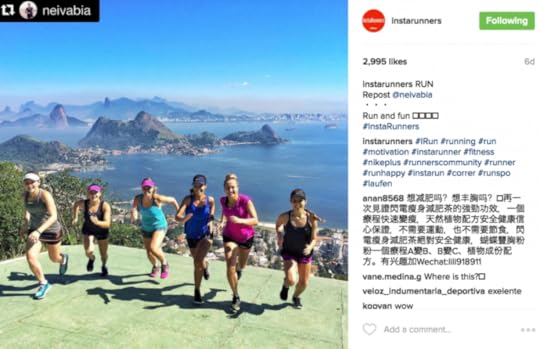
The best way to see what cool races or runs people are doing around the world is by following @instarunners. One of the first collective running accounts on Instagram, it reposts other runners' posts showcasing their running adventures. Include #InstaRunners on your post to possibly get featured on the account.
View Larger Image
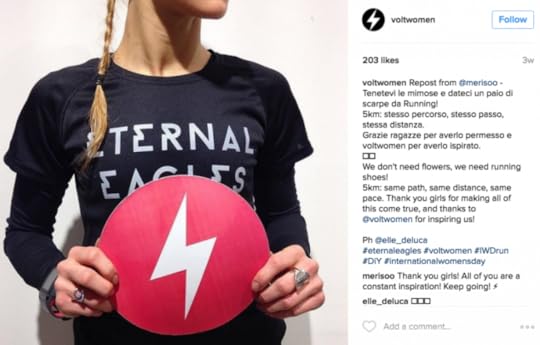
This account is dedicated to strong, fearless and active female runners everywhere. The photos are reposts of other women's amazing feats and a good reminder in finding support among your favorite gal pals.
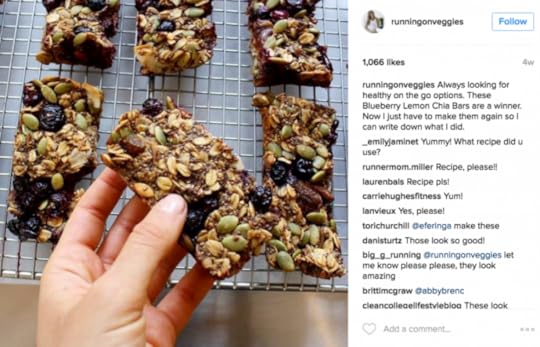
Food blogger and health coach Lottie Bildirici's Instagram account (named after her blog) makes a plant-based diet look delicious. This is healthy #foodporn made for endurance athletes who can use the recipes to fuel various workouts from swimming to cycling, and of course, running.
View Larger Image
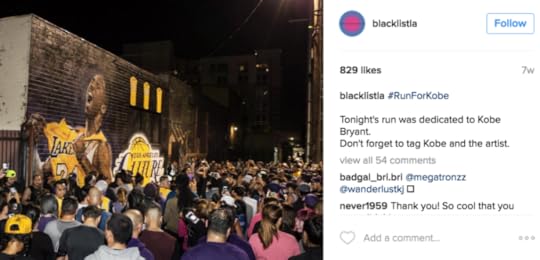
Discover Los Angeles' proliferating urban street art by following this account, or if you live in the area join the nighttime group runs with BlacklistLA that organizes it. Erik Valiente founded the running group BlacklistLA for locals to better know their city and each other, often riding on a 10-speed with a camera in hand to capture the runners and the final group photo in front of the destination mural—perfect for Instagram sharing.
View Larger Image
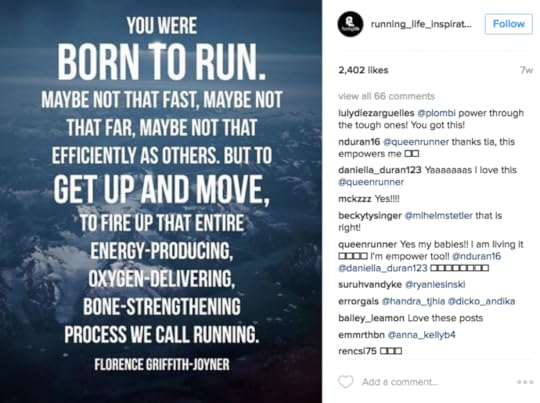
Need a little extra motivation before your run? These inspirational quotes might do the trick and could become a new running mantra.
View Larger Image
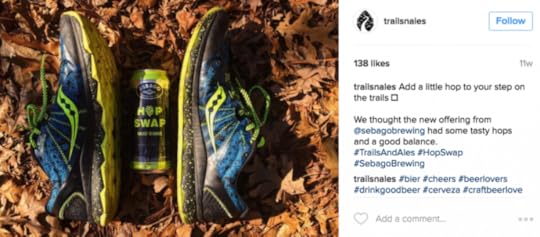
"Running our ales since 2014" is the tagline of this account showcasing craft brews on picturesque trails shared by runners across the country. It'll certainly expand both your trail and brew knowledge.
View Larger Image
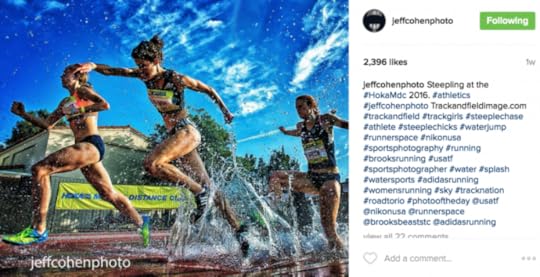
More than just stats and times, Jeff Cohen's photography captures striking images of elite runners at all the major track meets. He makes the action shot look as engaging as the pre-race standstill, and gives a behind-the-scenes look at the sport.
View Larger Image
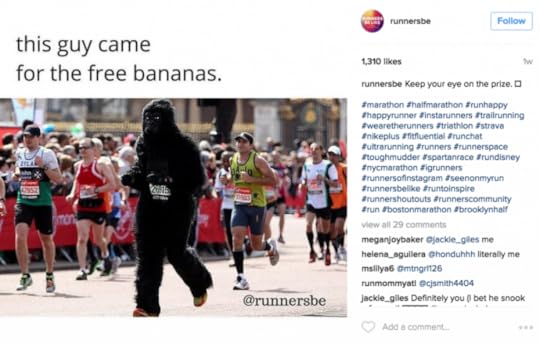
You know that post that's right on point and too funny not to share or tag a friend in? This account is full of them and the quirky things that runners do, and it will have you rolling with laughter because it's true.
View Larger Image
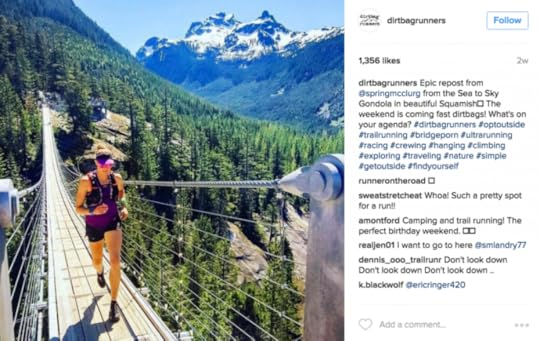
Dirtbag runners are a community of trail and ultrarunners around the world, snapping photos of their epic adventures. From breathtaking mountaintops to the depths of a canyon, these scenic images will have you wanderlusting for that next escape.
View Larger Image
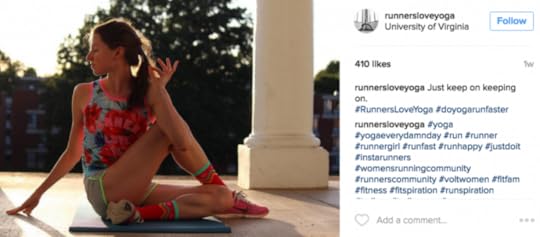
Get running and yoga tips from Ann Mazur, founder of the Runners Love Yoga instructional video series. Learn which yoga poses are best for runners who want to strengthen and prevent injuries.
View Larger Image
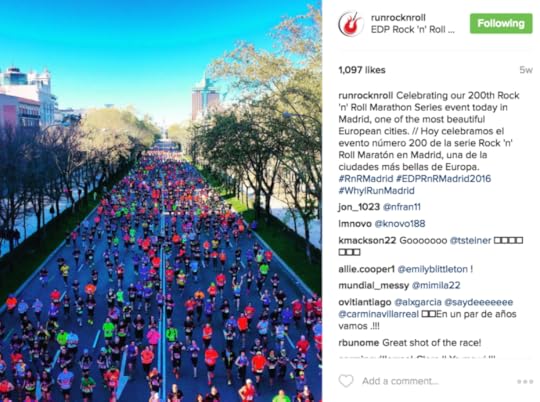
If you're a fan of concerts and running, then the Rock 'n' Roll Marathon Series' account will give you a decent dose of both. Get pumped for upcoming races or recap the weekend's events and festivities in case you missed it. Either way you'll find inspiration from the everyday to the elite runners that do these races.
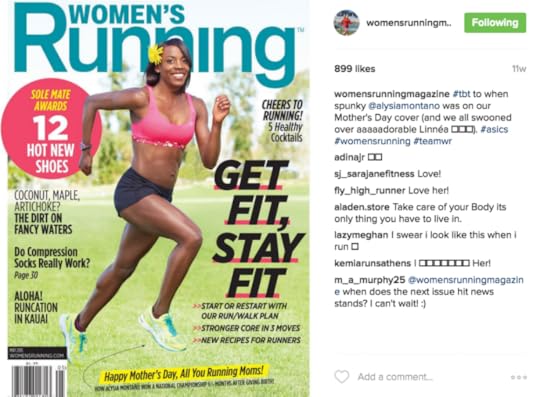
Aside from the magazine being a resource for everything and anything that has to do with women in running, Women's Running's Instagram account gives an exclusive look at what the magazine is working on, who they're meeting and where they're going. Run bloggers and female elites often do an Insta-takeover on their account, introducing runners to prominent names in the running community.
View Larger Image
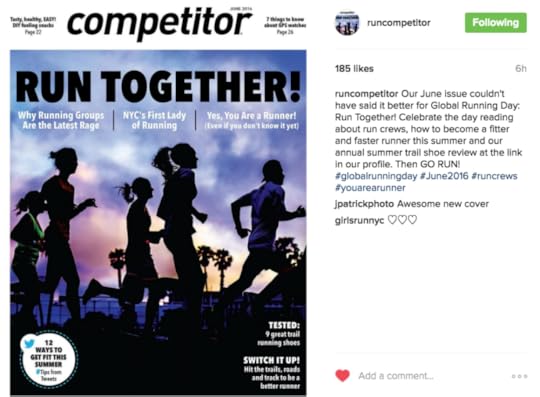
And if you don't already, follow us for all things running too!

More Galleries
The post 13 Instagram Accounts Runners Need to Follow appeared first on Competitor.com.
June 1, 2016
90-Year-Old WWII Veteran Serves Up Inspiring Bolder Boulder Finish
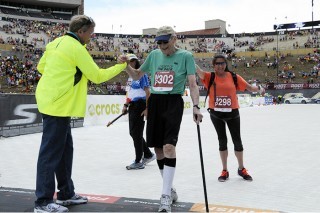
World War II veteran Jim McConnon is greeted by a finish line marshall after completing the Bolder Boulder 10K with his daughter, Linda, on May 30. Photo: Brian Metzler
By the time Jim McConnon entered the University of Colorado’s Folsom Field and began the final approach to the finish line of the Bolder Boulder 10K on May 30, the post-race Memorial Day celebration was nearly over. As soon as it concluded a few moments later, most of the estimated 45,000 spectators—many of whom had run the race earlier in the day—began to head for the exits.
But then a smattering of applause erupted from the southwest corner of the stadium, and it continued to grow louder. The clapping was for McConnon, who, slowly but surely, was bound and determined to reach the finish line. Aided by his daughter, Linda McConnon, and a friend of hers, McConnon hobbled his way with a cane toward the line as the cheering grew louder.
The 90-year-old World War II veteran from Philadelphia wound up being the final finisher of the 10K’s 38th running through the streets of Boulder, Colo. With his daughter at his side the entire way, he had slowly shuffled his way along the course amid an estimated 50,765 participants in the 99 citizen waves of the race—only to be held up for a bit near the 5-mile mark as the elite runners in the pro races zoomed through the streets later in the morning. He kept chugging along even after the pro races concluded and the country’s largest Memorial Day tribute began.
When he entered the stadium in time to hear 91-year-old Army veteran Stewart Boone play the National Anthem on a bugle, tears ran down McConnon’s face. Once the ceremony concluded with a 21-gun salute and a dual Navy F-16 fly-over, McConnon continued on the final 150 meters or so and crossed the line with a smile on his face at 12:41 p.m.—roughly 3 hours and 54 minutes after starting from the MP wave at 8:47 a.m. That’s about three times as long as it took the average Bolder Boulder finisher on Monday, but he wasn’t at all concerned about his time—just that he made it.
“I’m ready for a beer,” he said with a chuckle after reaching the finish.
McConnon, who served in the Naval Air Corps during World War II, has finished the Bolder Boulder seven times since 2003, which includes three times finishing as the first—and only—runner in his age division. Two years ago when he was 88, he finished in 2:35:48. His best time came in 2005, when he was 79 and finished in 1:30:35.
Suffering from neuropathy in his lower legs, he said this year was a bit more challenging because he has less strength and feeling in his legs than in previous years. He asked his daughter, who lives in Boulder, to accompany him along the course for the first time.
“I couldn’t have done it without them,” he said. “I feel just fine, but my legs are dead so that slowed me down and made it a long day.”
PHOTOS: More Than 50,000 Run in the 2016 Bolder Boulder 10K
Memorial Day has always been special to McConnon and his family. He lost one of his brothers, a pilot in the Army Air Corps, during World War II when his plane went down in Yugoslavia. “Four out of six boys in our family fought in World War II and one of us didn’t come back,” McConnon said. “Those were the days.”
Ten years ago, McConnon went to Europe to bring back his brother’s remains and met a family that had held his brother’s belt buckle in safekeeping for more than half a century.
“There was a family in the countryside that he went and met, and they told him, ‘We’ve been waiting for you,'” Linda said. “So Memorial Day is a big day for him and our whole family. I’m so happy that he made it, and that I was to be able to finish with him.”
McConnon’s finish provided a huge final shot of inspiration to those who witnessed it after the impressive Memorial Day tribute—which also included a military color guard, skydivers landing in the stadium with flags for each branch of the military and the honoring of veterans Col. Lee Van Arsdale (U.S. Army Delta Force), Chuck Chaldekas (Navy Seal), Dr. Ralph Christensen (U.S. Army), Dr. John Farrington(U.S. Army) and Lt. Col Donald Stonebreaker (U.S. Air Force).
Ryan Van Duzer, a Boulder native and Bolder Boulder finisher, was one of those who was there to cheer McConnon “and his team of angels” on from the stadium’s south stands.
“I heard faint cheering and turned around to see what was going on,” Van Duzer said. “His triumphant march, canes and all, caused people to stop their frenzied exit, turn around, and cheer him on. His spirit lifted me, and everyone else who managed to pick up on this amazing moment, to scream at the top of their lungs, and make sure that he received a hero’s welcome. These are the magical moments that make me love the Bolder Boulder.”
RELATED: Why the Bolder Boulder Should Be on Your Bucket List
Brian Metzler is the editor in chief of Competitor.com and Competitor Magazine.
The post 90-Year-Old WWII Veteran Serves Up Inspiring Bolder Boulder Finish appeared first on Competitor.com.
Run Across Haiti Featured in New Film With Dean Karnazes
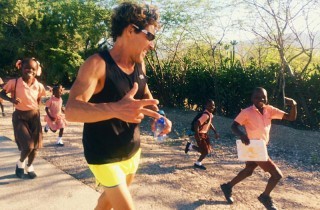
“Haiti affected me more than I affected the Haitians.” Photo courtesy of Dean Karnazes
As a nation, Haiti isn’t the first place to come to mind when you think of deeply ingrained running cultures. In fact, according to accomplished ultrarunner and author Dean Karnazes, the idea of running for pleasure is a foreign concept to Haitians who, in many cases, are simply struggling to survive. Yet running also has the ability to unite people.
Karnazes was one of 20 people who ventured to Haiti in February for the 2016 Run Across Haiti, a benefit for Team Tassy—a charitable organization founded by Ian Rosenberger in 2010. In addition to being Team Tassy’s largest fundraiser, the run is meant to be a vehicle to help end poverty through job training and placement.
Further, a new documentary short film released on June 1, follows Karnazes and his teammates on their 230-mile, eight day running odyssey from the northernmost tip of Haiti in Cap Haitian to it’s most southerly point in Jacmel. Unlike many adventure films, this one doesn’t have a crisp, happy ending. Haiti is impoverished, polluted and deforested, with no easy solution in sight.
“Haiti is so perfectly fucked up, you can’t imagine anyplace being worse,” says Karnazes, who, months after his return, is still overcome with emotion when recalling his Haitian experience. “Running in Haiti was the most hideously beautiful experience I’ve had in my life, and I’ve run all over the world. It wrecked my body, yet cleansed my soul.”
Karnazes also shared that Rosenberger is a “can-do guy” and just the person to tackle a seemingly unsolvable problem, like poverty in Haiti.
Rosenberger first visited Haiti in 2010 after the devastating, magnitude 7.0 earthquake. While there he met Tassy Fils-aime, who, at the time, had a life-threatening tumor. Rosenberger and his friends worked to bring Tassy to the U.S. and get him the treatment he needed. Once Tassy returned home, Rosenberger and his friends were pleased with what they helped accomplish, but they also realized their happiness was about them, not about affecting a bigger change in Haiti. That’s when they developed the model for Team Tassy, with a focus on helping one neighborhood at a time.
The group held their first Run Across Haiti in 2015, and it has since become the organization’s biggest fundraiser. Tassy was one of seven people to complete the initial run. Now a student at LaRoche College in Pittsburgh, Tassy joined the cross-country team to train for the run.
“It gave him a chance to see his country very intimately for the first time,” says Team Tassy Executive Director, Vivien Luk, of Tassy’s run. “The experience made him proud to be Haitian. We want to show that this isn’t a place to be scared of or pitied.”
According to Rosenberger, what makes the experience so unique and impactful is being on the ground and experiencing Haiti by foot, at six miles per hour.
“You take your vulnerability and set it against the noise, and smell and heat and poverty of Haiti, and you are able to experience it in a way that is completely unique,” says Rosenberger, who developed the idea for Run Across Haiti while running the Sahara Race in Namibia. “Prejudice and stereotypes are all stripped away, and you’re forced to confront what you thought about a place and the people who live there with what you now know about them. It’s intense, and beautiful and really effing scary.”
Seven out of 20 runners on the 2016 Run Across Haiti covered all the miles. As shown in the film, many became ill, overcome with exhaustion and overwhelmed in general. Hillary Allen, a fellow ultrarunner for The North Face with Karnazes, was one of the athletes who fell ill.
“People are reduced to nothing in Haiti, survival is their concern. Yet, they remain joyful, strong and resilient,” says Allen who battled not only being sick, but also the daily mental struggle of feeling as though what she was doing was trivial in comparison to what Haitians endure. “All that being said, the run allowed me to contribute and help, albeit in a small way. I want to use running as a means to help others, even if it is to bring awareness to distant communities.”
According to Karnazes, everyone in their group shared similar mental and physical struggles, making the collective experience all the more powerful.
“Our group bonded in the way people do when they experienced shared suffering, probably similar to what Haitians experience during daily survival,” says Karnazes. “Team Tassy is working, and we saw the direct impact. There’s just so much to be done.”
The 2016 run raised more than $140,000. Next year’s 2017 Run Across Haiti is in the works, and the goal is to have upwards of 50 runners, with a fundraising goal of $200,000. As the run grows, it also becomes a local job creator in Haiti.
“We’re beginning to train work-ready family members for paid positions on the 2017 crew,” Luk says. “The bigger the run gets, the more we can invest in jobs and the local economy. We’ll grow it according to our ability to run this logistically.”
Further isn’t going to leave viewers with warm and fuzzy feels. Instead it opens up the possibility for conversations about the state of the world, affecting change through sport and understanding other cultures. It also gives an intimate, albeit abbreviated, sampling of what it’s like to run across Haiti, minus the olfactory overload, constant noise and some of the chaos—which Karnazes likened to being in a Mad Max movie.
“Beyond telling their friends and family how beautiful and amazing Haiti is, I hope the run sets a foundation for how we think a dialogue about poverty should begin,” Rosenberger says of what he hopes people take away from the run. “Over the course of a week spent running more than 200 miles with strangers, you learn that rich or poor, we all want the same things: a roof over our heads and our kids to have a better life than we did. If people cross the finish line having felt that, even for a minute, we’ll have done our job.”
To learn more, go to teamtassy.org.
The post Run Across Haiti Featured in New Film With Dean Karnazes appeared first on Competitor.com.
Trail of the Week: Old Coast Road, Big Sur, Calif.
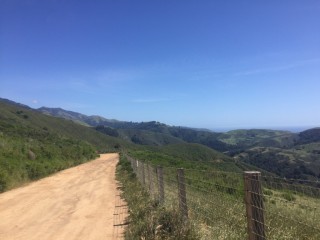
A southward view from the top of the first climb along Old Coast Road. Photo: Allison Pattillo
Long before completion of famously breathtaking Bixby Bridge in 1932, Coast Road was the land route travelers used to go from Carmel to Big Sur. The single-lane dirt road still exists and makes for an incredible run from the north side of Bixby Bridge to Andrew Molera State Park, 10.5 miles to the south. As the road passes through private land (no trespassing!), be prepared to encounter the occasional property owner, cattle, four-wheeling tourists, cyclists and other runners or hikers.
Given that this is a point-to-point route, you’ll need to consider how you to get back to your car—either drop a car the southern end of the route and shuttle back to the start with a running partner, thumb a ride at the end or run the route in both directions for a burly 21-mile day.
Park in one of the pullouts on the north side of Bixby Bridge, and begin running at the intersection of Coast Road and Highway One, heading inland on Coast Road. Not only is the road easy to follow, there are distance markers, albeit at unusually frequent intervals, all along the way.
There’s a slight climb at the beginning and about half a mile in is a great view looking towards Bixby Bridge and the Pacific Ocean. From the initial arid and breezy conditions, the route drops down about 400 feet into Bixby Canyon, which is lush and humid.
After a brief flat section and passing over Bixby Creek, the road turns up, winding out of the Canyon between Sierra Hill and Bixby Mountain. The runnable incline is about three-miles long. There are glimpses of neighboring ridgelines through the trees, but the real show is the dappled light and diverse plant life including enough wild flowers, towering redwoods and giant ferns to make you feel like you are in the middle of nowhere. Just before the top of the climb at 1,200 feet, there’s a massive, moss-covered rock wall to the left.
The road down into Little Sur Canyon is twisty, fast, exposed and also the rockiest section along the route. It flattens out at the bottom of Little Sur Canyon, for one of the longest level stretches—more than half a mile.
After crossing over Little Sur River, the road turns up again, passing through cattle and horse pastures and windswept, grassy meadows. It’s not as steep as the first climb, topping out just shy of 1,000 feet. If the weather allows, there are great views of Pico Blanco, so named because of its marble and limestone peak.
The road heads downhill, more or less, for the last two miles, passing through part of Los Padres National Forest, before ending at Highway One.
The post Trail of the Week: Old Coast Road, Big Sur, Calif. appeared first on Competitor.com.
The 3 Stages of Proper Marathon Recovery
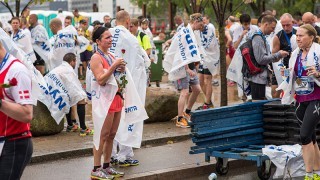
Marathon recovery cannot be taken lightly. Photo: DFAagaard / Shutterstock.com
The marathon is one of running’s ultimate goals. Because of its distance at 26.2 miles, it takes dedication and a considerably lengthier training period to complete. And just as the training must be more serious, so must the marathon recovery. Racing a marathon results in a lot more “damage” than simply sore muscles:
Immune function is suppressed—making it more likely that you’ll get sick after the race
Strength is reduced (and inflammation and cell damage persists for up to two weeks after the marathon)
Even the heart may be damaged (while more common in beginner runners, remember that the heart is a muscle and will heal just fine!)
Muscle memory and coordination is compromised, making it more likely to get injured while running fast in the 2-3 weeks after the race
Most of these issues are far less serious or non-existent for shorter races, making adequate marathon recovery paramount to your future training.
So no matter if you’re at the back of the pack or trying to run fast at the Boston Marathon, prioritizing recovery after the race is critical.
Proper marathon recovery can be divided into three general timeframes: the day of the race, the day after the race, and the week after the race. Let’s dive into the first stage.
Stage 1: The Day of the Race
Marathon recovery starts as soon as you cross the finish line. Walk for at least 10-15 minutes to cool down, rather than sitting or lying down immediately after the race.
At most marathons, there will be fluids and food available—take advantage of them! As soon as possible, start getting in water, electrolytes, and calories to jumpstart the recovery process.
Refueling for recovery is different than eating for health. While it’s important to eat nutritious foods, at this point it’s most critical to begin the rebuilding process. Focus on foods high in carbohydrate (you’re in a carb-depleted state at the end of a marathon) and electrolytes that have some protein as well.
As soon as your stomach can handle more substantial food, aim for a well-balanced meal. But since you did just finish a 26.2 mile race, it’s OK to treat yourself!
Remember that recovery isn’t just about what you do, but what you don’t do. Avoid celebrating with more than 1-2 alcoholic drinks that will just further dehydrate you and negatively affect the absorption of nutrients. Also avoid any massage on the day of the race, which will further exacerbate muscle damage.
Later in the day, after you’ve had a chance to shower and eat, it’s still a good idea to avoid any form of self-massage or other exercise. Your body is in “fight or flight” mode and needs rest.
An ice bath is a helpful tool to help curb the inflammation that is at peak levels throughout your body. If possible, use a bag of ice in a tub of cold water and immerse your lower body for 10-15 minutes. While this form of cryotherapy has been shown to limit the adaptation process, after a marathon the goal is recovery (not adaptation).
Continue to hydrate and consume electrolytes to help flush exercise byproducts from your bloodstream and muscles. After a much-deserved “cheat meal,” focus on nutritious foods like vegetables, healthy meat, fruit, nuts and seeds, and whole grains.
If possible, take a nap. Sleep is when the body is most efficient at muscle repair and removing exercise byproducts like free radicals, so aim for a 90-minute nap that will allow you to get through a full sleep cycle.
Stage 2: The Day After the Marathon
After a (hopefully!) good night’s rest, you can continue the marathon recovery process with some light activity. It’s not recommended to run the day after a marathon because of the repetitive impact, but a short, easy walk will promote healing blood flow. You can also choose a non-impact form of cross-training like cycling, pool running, or swimming.
It’s preferable to choose cross-training in the pool as the effects of the water will help the healing process. Due to the water pressure, there will be extra blood flow to your extremities that will aid recovery.
Now is also a good time to get a massage if you can. Keep it light and therapeutic—now is not the time to get a deep tissue or sports massage. Alert your masseuse that you’ve just run a marathon and they will keep the pressure light to enhance blood flow rather than remove myofascial adhesions or scar tissue. That’s best reserved for 1-2 weeks after the race.
Continue to hydrate well and eat nutritious food. Recovery takes 2-4 weeks to complete and it’s ideal to give your body the best fuel possible.
Stage 3: The Week After the Marathon
Most runners rush back into running because they’re either excited because of a big PR they just ran or they want vengeance after a bad performance. Stay patient! It’s best to take at least 5-7 days off from running entirely to let muscles and connective tissues heal.
After 3-4 days, begin some easy, short cross-training sessions like swimming, pool running, or cycling. The goal is movement, not performance, so keep the effort very easy.
You can also start some light strength exercises or mobility work that will help you transition back to running soon. Just avoid heavy weightlifting in the gym—the body is not ready for that yet!
Prioritize sleep the week after the marathon to ensure you’re mentally and physically ready to run after about a week off. Once the time comes, you can start with a very easy 20-30-minute “test run” to see how your legs feel. The goal with a test run is to diagnose any aches or pains and to also see how recovered you feel.
If your legs still feel incredibly heavy or anything hurts, you know you need several more days to rest.
The marathon is a rewarding and challenging event. But the hard work continues long after you cross the finish line to maximize your marathon recovery, return to running, and hopefully another personal best at your next race!
* * *
About the Author:
Jason Fitzgerald is the head coach at Strength Running, one of the web’s largest coaching sites for runners. He is a 2:39 marathoner, USATF-certified coach and his passion is helping runners set monster personal bests. Follow him on Twitter @JasonFitz1 and Facebook.
The post The 3 Stages of Proper Marathon Recovery appeared first on Competitor.com.
Workout of the Week: Alternating 400s
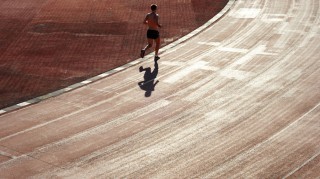
The Alternating 400s workout takes a lot of discipline in order to execute properly and stay on pace. Photo: www.shutterstock.com
This challenging track session teaches you to recover while running fast.
Need a challenging workout you can do year-round, regardless of your specific training focus?
Look no further than 400s on the track—but with a slight twist. Rather than busting out a handful of one-lappers as fast as you can with a long, hand-on-knees recovery between repeats, alternate running 400m at your 5K-10K pace with a 400m “recovery” lap 10 seconds slower than the one you just completed. The catch? These aren’t really 400m repeats—it’s a continuous workout. No stopping!
So how long should you go? Until you can no longer maintain the target paces, explains Nate Jenkins, an elite runner and coach based in Andover, Mass.
Jenkins, seventh-place finisher at the 2008 U.S. Olympic Trials Marathon who represented the U.S. at the 2009 world championships, says, “This is a workout you could do every week of the year and have it be the right workout at the right time. You get some specific work but the faster rests prevent it from becoming so anaerobic that it is dangerous in the base phase.”
Here’s how you do it:
If your current 10K race pace is 8 minutes per mile, that breaks down to 2:00 per 400m. For this workout, alternate running one lap at 2:00 with a “recovery” lap at 2:10 (8:40/mi pace) until you can no longer maintain those paces. Alternating 400s, a similar workout to Deek’s Quarters, takes a lot of discipline in order to execute properly and stay on pace. It’s a great benchmark workout—one that you can repeat every few weeks as a means of tracking your progress. As your fitness level improves over the course of a training cycle, try running your faster laps closer to 5K pace, which means your “recovery” laps will also speed up a bit. If you can run more laps at the same pace than the last time you completed the workout, it’s a sure sign that your fitness is improving.
RELATED: Deek’s Quarters
“This is a great threshold workout,” Jenkins says. “It also really forces you to relax at quick speeds. Too often we hammer workouts and extend rests to hit times and that is counter-productive because there are no rests on race day. This forces you to recover while running pretty quickly and to relax while running race pace because if you aren’t relaxed at pace you won’t be able to recover during the quick 400m rest.”
The post Workout of the Week: Alternating 400s appeared first on Competitor.com.
May 31, 2016
Celebrate Global Running Day on June 1
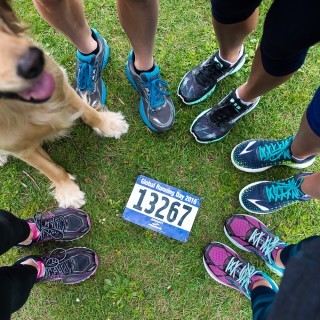
Wednesday, June 1 is Global Running Day! What does that mean? It means it’s a great day to lace up your shoes and go out and celebrate running by going for a run or getting a friend or co-worker out for a run. It’s also a good time to start planning ahead for a late-summer or early fall race by using the day to build momentum and fitness throughout the summer.
In theory, every day is global running day—or it should be! But there are some great reasons to tune in to this worldwide phenomenon aside from just going for a run. Here’s a rundown of what’s happening on Global Running Day and how some races, organizations, coaches and runners are participating in the celebration of the worldwide event.
Rock ‘n’ Roll Marathon Series
The Rock ‘n’ Roll Marathon Series (which is owned by Competitor’s parent company) is having its biggest race registration sale of the year—but the price-slashing discounts are only available on June 1, starting at Midnight PT and ending at 11:59 p.m. PT.
Upcoming races include tour stops in Seattle, Chicago, Dublin, Virginia Beach, Philadelphia, Montreal and San Jose. Learn more at the Rock ‘n’ Roll Global Running Day page.
RELATED: Yes, You Are a Runner!
New York Road Runners
The New York Road Runners have organized a special youth running program for more than 2,000 New York City public school students. School kids in grades 3 through 8 will participate in the Mighty Milers Fun Run at Icahn Stadium as part of the Million Kid Run on Global Running Day. The day will include a variety of races, games, and fitness-related activities. Chirlane McCray, the First Lady of New York City, will join students in the celebration, and 2016 U.S. Olympic team hopefuls Nicole Tully (5,000-meter run), Ashley Higginson (3,000-meter steeplechase) and Kyle Merber (1,500-meter run) will be there to cheer for the youth runners and help hand out finisher medals.
The New York Road Runners are encouraging runners of all ages and abilities to register and pledge miles to the free Global Running Day Million Kid Run program. As of May 31, more than 2.3 million people from 168 countries have pledged to run on Global Running Day at globalrunningday.org.
“Global Running Day and the Million Kid Run provide a platform for us to inspire our local and global running community alike, parallel with New York Road Runners’ mission to help and inspire people through running,”says Michael Capiraso, New York Road Runners President and CEO. “Two million people and counting have pledged to run on Global Running Day, and in New York City, we’re excited to welcome runners of all ages and abilities to our free events in all five boroughs, all day long.”
RELATED: New Runner—Everything You Need to Know to Get Started!
Generation UCan
Generation UCan, the makers of nutritional energy drinks, has organized a free online running seminar with an amazing collection of coaches and athletes. The event kicks off at 12:00-12:45 p.m. ET with ZAP Fitness coach Pete Rea talking about “The Mental Side of Running” and then continues with 2004 Olympic runner Carrie Tollefson and Dr. Cathy Yeckel, an assistant clinical professor of epidemiology at the Yale School of Public Health, talking about “Women on the Run” from 1:00-1:45 p.m. ET. After that, Dathan Ritzenhein, a three-time U.S. Olympic runner, and Amy Yoder Begley, a 2008 Olympian and head coach of the Atlanta Track Club, will discuss “How to Train Like a Champion” from 2:30-3:15 p.m. ET. The event will conclude with exercise scientist and renowned coach Greg McMillan sharing “Tips to Avoid the Nutrition Wall” from 5:00-5:45 p.m. ET. For more details on how to sign up and watch it live or get a transcript of the event emailed to you, go to the Generation UCan GRD site.
Brooks Running
In celebration of Global Running Day, Brooks is sharing eye-opening revelations about runners—from their source of inspiration to how they take advantage of post-run endorphins. According to the fourth annual Brooks Global Run Happy Report, running rejuvenates your creative juices and improves your mood. The survey results clearly reveal that the power of running is fierce and goes far beyond the time you start and stop your watch. For nearly all runners (97 percent), running makes their day better. In addition to sculpted legs and a healthy heart, the miles offer a blank canvas for new, creative ideas. Fifty-seven percent of runners reported they’re most likely to come up with their most creative ideas on the run versus in the shower (18 percent) or in the car (13 percent). But not all run-induced ideas are life altering. In fact, on-the-run thoughts range from accomplishing the run (31 percent) to sex (8 percent).
At the Brooks Running Global Running Day site, you can print out virtual race bibs, find running events and post a pic of your Global Running Day pursuits.
RELATED: Global Running—Running Adventures Around the World
Big Sur Marathon
In honor of Global Running Day, June 1, the Big Sur International Marathon organization is encouraging all former participants and volunteers from any of its annual events to proudly wear a race or Big Sur event volunteer shirt. On the Monterey Peninsula, the Wednesday Night Laundry Runners local running group will celebrate at its weekly group run/walk on June 1 beginning at 5:30 p.m. from Mission Linen at Congress Avenue and Sunset Drive in Pacific Grove. In Salinas, the training group for the Salinas Valley Half Marathon will log miles at its Wednesday evening track workout at Hartnell College. (The Big Sur International Marathon is also participating in the Million Kid Run Program.)
Twin Cities Marathon
Twin Cities In Motion, the organizers of the Medtronic Twin Cities Marathon and a host of running events throughout the year, will again lead Global Running Day activities in the Twin Cities area. Twin Cities In Motion asks runners to visit tcmevents.org/community/global_running_day for all event information and tools including a finisher certificate and a link to pledge miles online at globalrunningday.org. TCM also encourages runners to tweet photos to @tcmarathon using the hashtag #GlobalRunningDay and consider registering for one of its upcoming events. Running Room, Twin Cities In Motion’s local partner for Global Running Day and the official Medtronic TC 10 Mile training program, is hosting free group runs at their Uptown Minneapolis (1433 West Lake Street) and St. Paul (1068 Grand Avenue) stores at 6:00 p.m. Wednesday, where runners can enjoy light refreshments and prize giveaways, courtesy of Twin Cities In Motion and Running Room.
The post Celebrate Global Running Day on June 1 appeared first on Competitor.com.
Yes, You ARE a Runner!
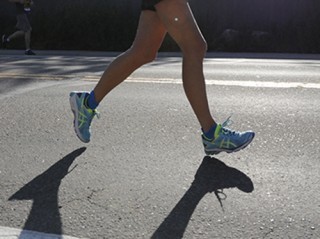
Celebrate Global Running Day on June 1 by going for a run!
“In running, it doesn’t matter whether you come in first, in the middle of the pack, or last. You can say, ‘I have finished.’ There is a lot of satisfaction in that.” —Fred Lebow, founder of the New York City Marathon
Repeat after me: I am a runner.
Again, but louder: I am a Runner!
Once more, with gusto: I AM A RUNNER!
And one last time so everyone can hear you: YES, I AM A RUNNER!
In one of the oddities of American culture, there are millions of people who run on a semi-regular basis and even run races a few times a year but yet don’t seem to consider themselves runners. It’s strange because running is by far the simplest and most accessible recreational and fitness activity known to mankind. (And no, I’m not considering walking the dog or doing “12-ounce curls” to be a part of this discussion.)
If you own running shoes and put them on to run a few miles at a time a couple of times a week for any reason at all, then, yes, you are most certainly a runner. It doesn’t matter how fast you run or how long you run. It doesn’t matter if you have ever run a race and, even if you have, it doesn’t matter how fast you have run those races.
The simple definition of running is that you put one foot in front of the other and move your body faster than your walking pace. It’s an exclusive club but it’s open to anybody and everybody. If you haven’t been a runner before, today is the ideal day to begin!
In celebration of Global Running Day on June 1, all you have to do is admit to yourself that you’re a runner and go out for a run!
YES, I AM A RUNNER!
You don’t have to tell anyone else, but you can share it with friends or on social media, if that’s your thing. But you don’t need to explain yourself to anyone about how, why, when or where you run. Every single day of the year can be Global Running Day, a celebration of your own personal health, happiness and holistic balance.
RELATED: New Runner—Everything You Need to Know to Get Started!
For some, the sole point of running is to move as fast as possible from Point A to Point B. But there are dozens of reasons to go running regularly.
You can run to improve your fitness! Yes, that might mean you can run faster for a 10K race or half marathon, but it also might mean that you can walk a flight of stairs easier, sleep better and live a healthier lifestyle.
You can run to reduce stress! No one has to remind us that we live in stressful times. It’s a crazy world we live in. But, as anyone who has ever run will attest, running can help reduce the tension from work, school, family, relationship or various other life situations. Even without putting much effort into it, running can help you be a more grounded and well-balanced individual.
You can run to lose weight! We’ve all heard about the obesity epidemic in the U.S., but running doesn’t have to be boiled down to that. The societal changes of the past 50 years—namely processed food, more corn syrup in everything, longer working hours, more digital distractions (from TV to texts)—probably mean we all could use more exercise and better daily habits in our lives. And it can all start with the simple act of an easy run that is repeatedly consistently several times every week.
You can run to be social! It used to be that you’d go to a coffee shop, a bar, the water cooler or break room in your office or a friend’s house to socialize with your friends, family and co-workers. Now you can join or create a running group and chat the miles away. From running shop runs to happy hour runs to training groups to races, running can be as much of a social outlet as it is a physical outlet if you want it to be.
You can run to be free! Nothing helps rejuvenate the mind, body and soul quite like going for a run and feeling the breeze against your face, the pulsing muscles in your legs and the calmness in your brain. It’s not that you’re running away or trying to escape your challenges, it’s that you’re able to find solutions to them while you’re out running and clearing your mind.
You can run to change your life! Sometimes in life, we get stuck in a rut we can’t seem to escape. That’s life, right? Yes, but I guarantee that if you were to make the commitment to run as few as 3 to 5 miles several times a week for a month you’ll find you’ll be capable of (and experience) amazing life-altering changes. Whatever challenges puzzles, riddles or dilemmas life throws at you can start to be solved by consistent running.
You can run for no reason at all! Sometimes it’s good just to get out and run with no agenda at all. I’ve never once come back from a run and wished I hadn’t gone. Just run, baby!
Back in the dark ages of the great American running boom (yes, way back in the 1970s), there used to be a distinction between runners and joggers.
The runners were the super-fit, rail-thin nerdy types wearing nylon split shorts, T-shirts and cheap plastic stopwatches who were always bantering on about workouts and race times. Oh, and also running very fast most of the time.
Back then, anyone not fitting that description was considered a jogger. The terms weren’t derogatory, they were just how people identified themselves. Early on, the people who wanted to join the fitness craze of recreational running and imbibe the numerous benefits often self-identified as joggers just because they knew they somehow didn’t fit into that subset of super-fit, rail-thin nerd subset of people.
Nowadays, we’re all runners and we’re all doing the same thing, even if we’re doing it in our own way.
It doesn’t matter how fast or slow you run. It doesn’t matter what you wear to run—skimpy shorts, brightly colored compression socks or a frilly tutu!
It doesn’t matter where you run or what surface you run on—roads or trails or a track or a treadmill.
And it doesn’t matter where you came from—as a runner or as a human being. It’s all about where you’re going!
We can all feel the benefits, joys and excitement in different ways, and that’s the point. Running is there for all of us to enjoy, each in our own way.
If you run in any way at all, then, YES, YOU ARE A RUNNER!
Happy Global Running Day!
Brian Metzler is the editor-in-chief of Competitor.com and Competitor magazine.
The post Yes, You ARE a Runner! appeared first on Competitor.com.
Photos: More Than 50,000 Run the 2016 Bolder Boulder 10K
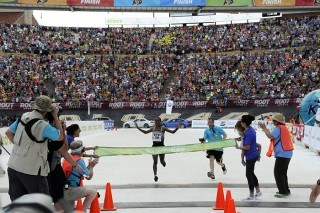
The 38th running of the Bolder Boulder 10K—one of Competitor’s must-do 10Ks—drew an estimated 50,765 participants to the streets of Boulder, Colo., on Monday in a celebration of fitness, fresh air and Memorial Day. The race is one of the fastest and deepest in the country—more than 500 runners broke 40 minutes this year—but it has a community atmosphere with bands, belly dancers, costumed runners, Slip ‘n’ Slides and unofficial aid stations with beer, bacon and cupcakes. Brandon Johnson, 28, of Denver won the citizen’s race title in 30:34, while Boulder’s Melissa Doc, 34, was the top women’s finisher in the open race in 35:44. In the pro races that capped off the day, Kenya’s Isaac Mukundi was the top finisher in 29:12, while Ethiopia’s Amane Gobena was the top woman in 33:39.
RELATED: Why the Bolder Boulder 10K Should Be on Your Bucket List
Scroll through the photos below to see some of the highlights of the 2016 Bolder Boulder. (For results, go to the Bolder Boulder site.)
Photo Gallery
1 of {count}
Back to Start
View Larger Image
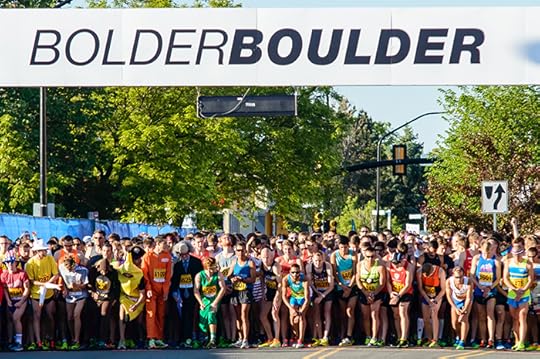
2016 Bolder Boulder 10K
The "A" wave of the citizen's race always gets off to a fast and furious start. Keep your eye on the runners in the monkey suit and the banana costume at the left. Photo: Peter N. Jones
View Larger Image
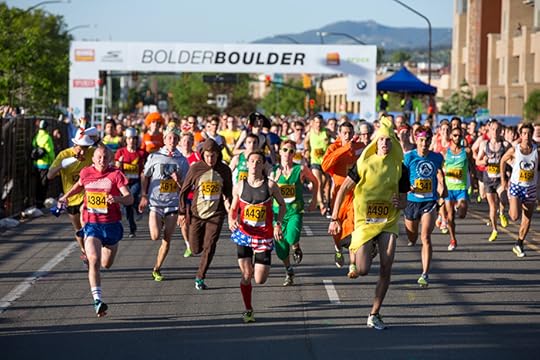
2016 Bolder Boulder 10K
The guy in the banana costume, 20-year-old Steven Goldy, sprinted to an early lead at the start while being chased by the guy in the monkey suit, 17-year-old Nathan Herr. They slowed considerably and came through the first mile in 8:30 en route to finishing in 8,306th and 8,307th place place in 57:20. Photo: Glen Delman
View Larger Image
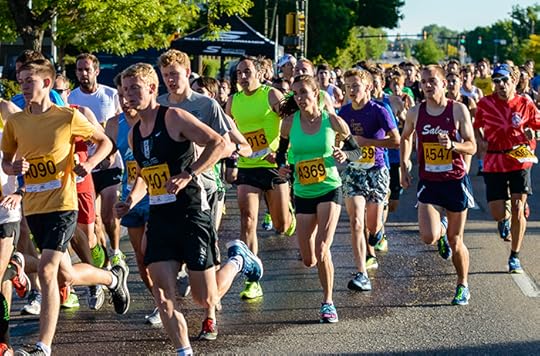
2016 Bolder Boulder 10K
Cool weather in the morning helped 114 runners break 36 minutes at the front of the pack. Photo: Peter N. Jones
View Larger Image
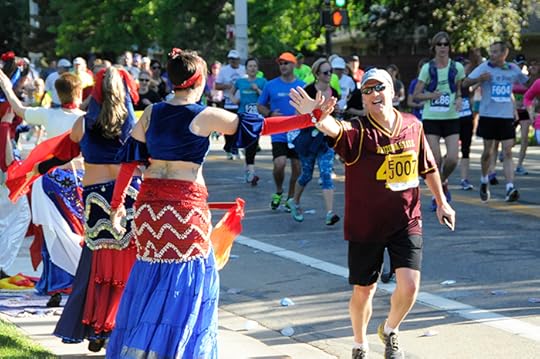
2016 Bolder Boulder 10K
The Bolder Boulder has been famous for its course-side attractions, including several groups of belly dancers. Photo: Brian Metzler
View Larger Image
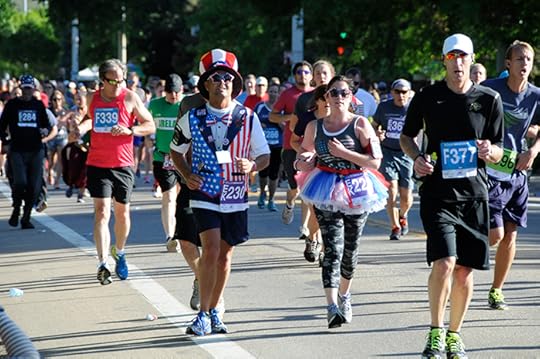
2016 Bolder Boulder 10K
Many runners were dressed up with patriotic garb to celebrate Memorial Day. Photo: Brian Metzler
View Larger Image
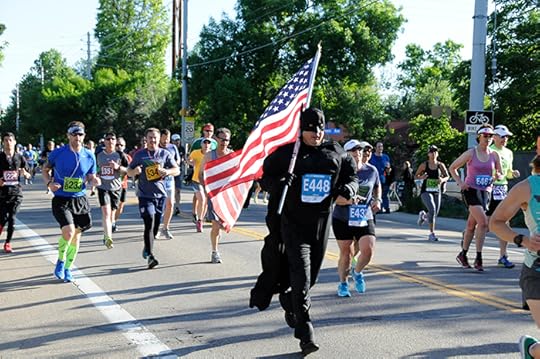
2016 Bolder Boulder 10K
Even Batman had a patriotic flair. Photo: Brian Metzler
View Larger Image
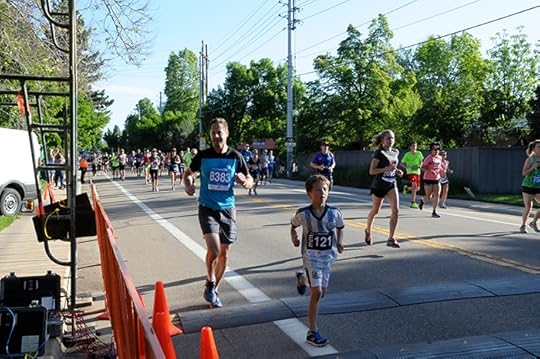
2016 Bolder Boulder 10K
Boulder resident Mark Eller celebrated his 49th birthday by running with his son, Sam, en route a 57:30 finish.
View Larger Image
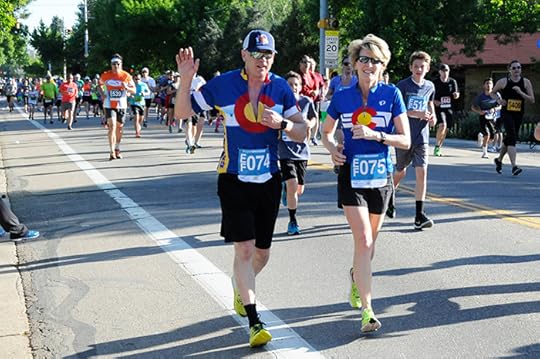
2016 Bolder Boulder 10K
Since the race began in 1979, more than 1.3 million runners have run the Bolder Boulder. Photo: Brian Metzler
View Larger Image
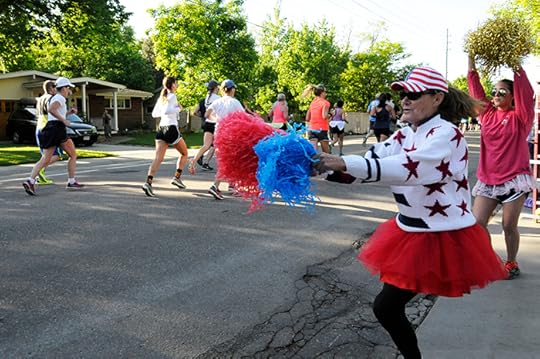
2016 Bolder Boulder 10K
"Miss Tutu" has been cheering on runners near the 3-mile mark for more than 20 years. Photo: Brian Metzler
View Larger Image
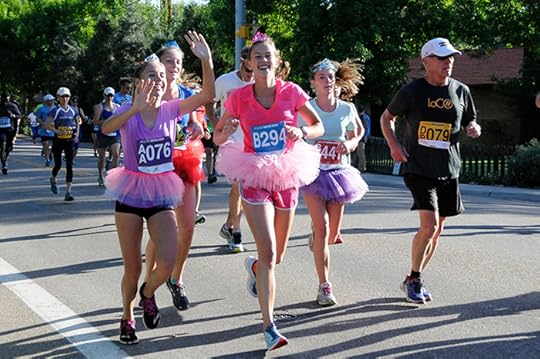
2016 Bolder Boulder 10K
Running in a tutu is still a big thing at the Bolder Boulder. Photo: Brian Metzler
View Larger Image
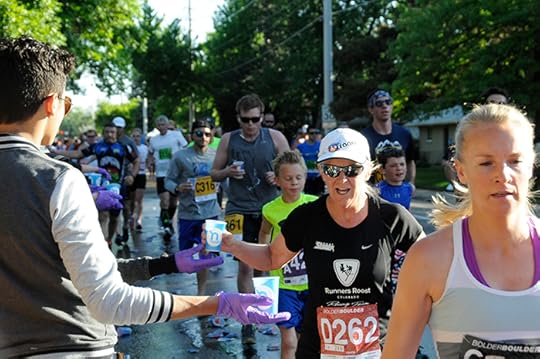
2016 Bolder Boulder 10K
Runners and walkers chugged down more than 15,000 gallons of fluid from aid stations during the race. Photo: Brian Metzler
View Larger Image
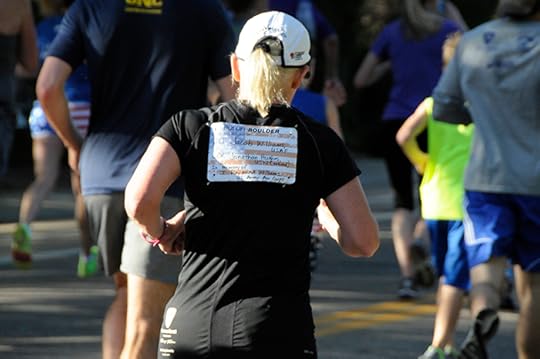
2016 Bolder Boulder 10K
Many runners ran with memorial race bibs honoring someone who served in the military. Photo: Brian Metzler
View Larger Image
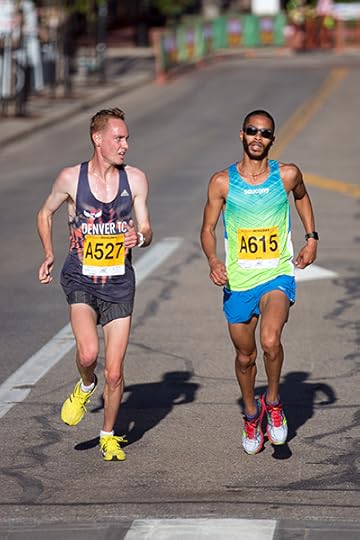
2016 Bolder Boulder 10K
Thanks to a 4:51 second mile, Ian Butler (left) built a huge early lead through the 5K mark of the citizen's race, but Brandon Johnson tracked him down before the 5-mile mark and ran away with a 34-second victory in 30:34. Photo: Glen Delman
View Larger Image
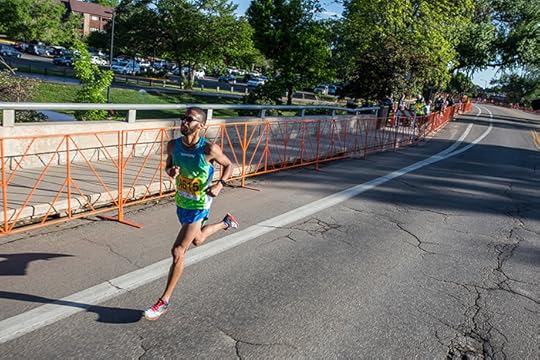
2016 Bolder Boulder 10K
Johnson's fastest mile was his fifth—4:43, the quickest in the citizens field—and his final time was six seconds faster than that of last year’s winner. Photo: Glen Delman
View Larger Image
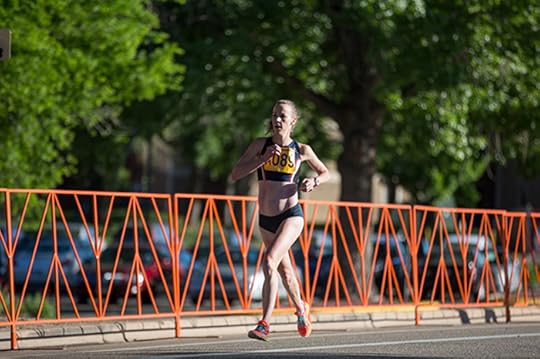
2016 Bolder Boulder 10K
Melissa Dock of Boulder ran strong to secure the women's citizen's race title in 35:44. Photo: Glen Delman
View Larger Image
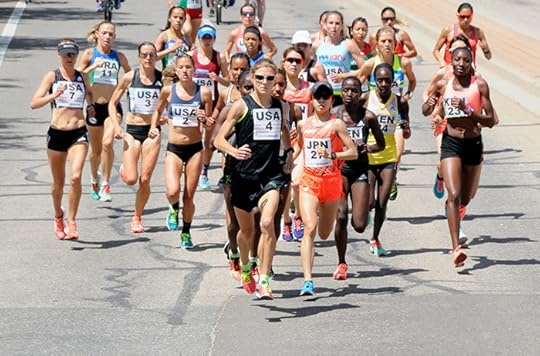
2016 Bolder Boulder 10K
American Lindsey Scherf was the early leader of the elite women's race, pacing the field through the first two miles in 5:25 and 5:32. Photo: Lucy Simich Metzler
View Larger Image
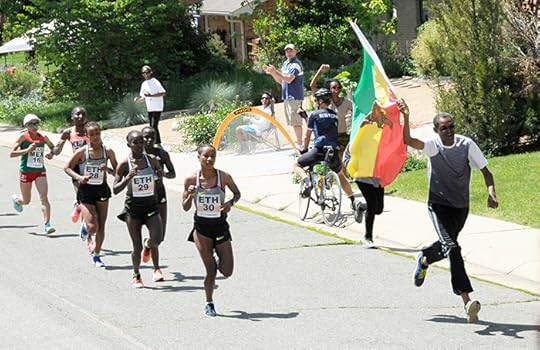
2016 Bolder Boulder 10K
Just as Ethiopian Amane Gobena made a surge to break away from the lead pack, an Ethiopian fan ran alongside her with her national flag to cheer her on. Photo: Lucy Simich Metzler
View Larger Image
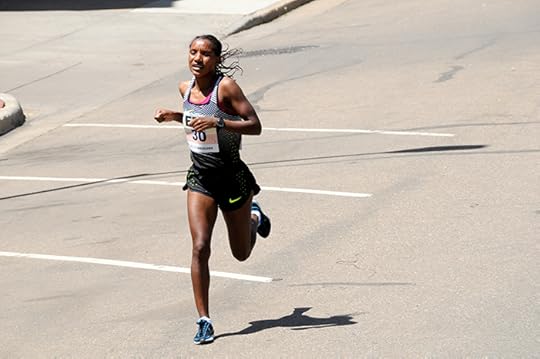
2016 Bolder Boulder 10K
Ethiopian Amane Gobena surged from the pack with a 5:20 fourth mile and a 5:15 fifth mile to distance herself from the rest of the runners. Photo: Lucy Simich Metzler
View Larger Image
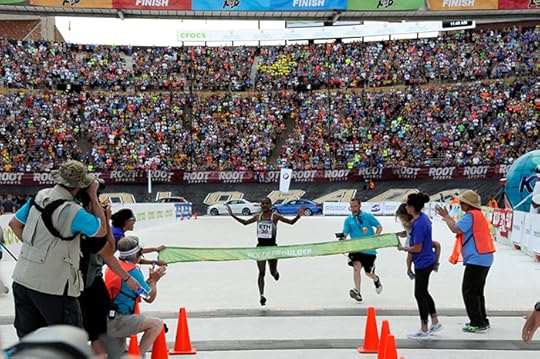
2016 Bolder Boulder 10K
With an estimated 40,000 Bolder Boulder runners and spectators filling Folsom Field on the University of Colorado campus, Ethiopian Amane Gobena was the first runner to reach the finish line in the elite women's race. Photo: Brian Metzler
View Larger Image
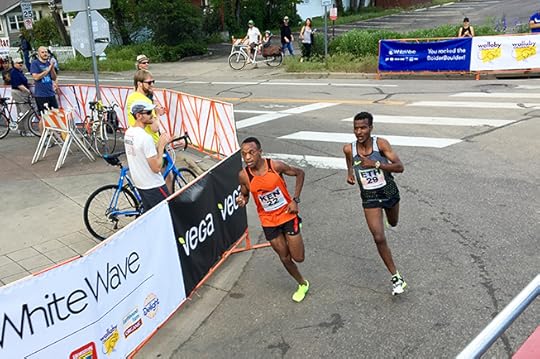
2016 Bolder Boulder 10K
In the men's pro race, Kenyan Isaac Mukundi battled with Ethiopian Terefe Debela in the final miles. Photo: Glen Delman
View Larger Image
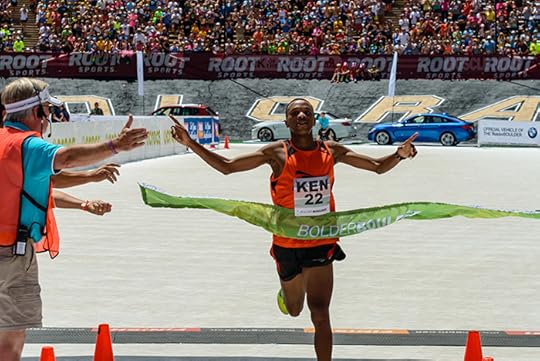
2016 Bolder Boulder 10K
Kenyan Isaac Mukundi charged to victory of the men's elite race in 29:12. Photo: Peter N. Jones
View Larger Image
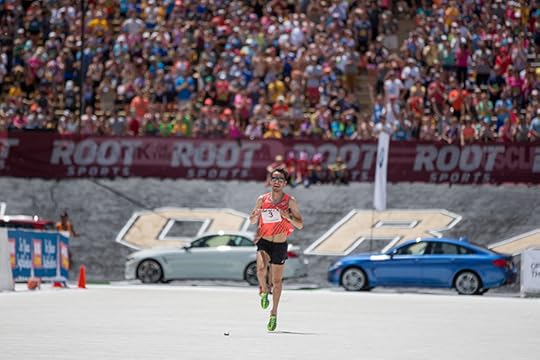
2016 Bolder Boulder 10K
American Diego Estrada finished third overall (29:40) in the men's pro field and helped the USA Red team to a second-place finisher. Scott Fauble placed 6th (29:54) and Abdi Abdirahman was 8th (30:04) to boost the American team. Kenya narrowly edged the Americans to win the men's team title. Photo: Glen Delman
View Larger Image
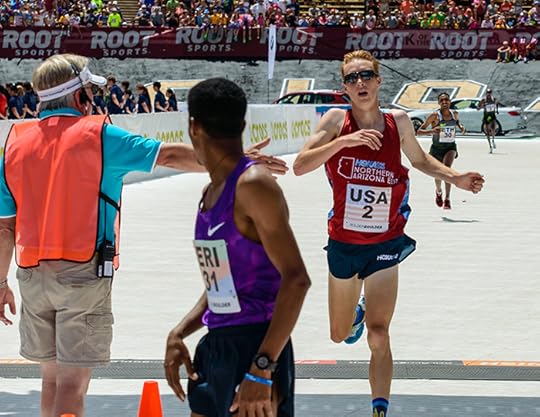
2016 Bolder Boulder 10K
American Scott Fauble placed 6th overall in 29:54. Photo: Peter N. Jones
View Larger Image
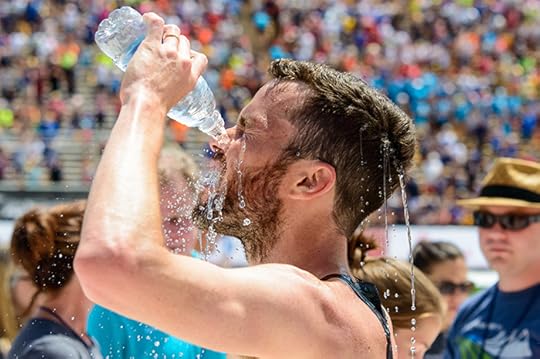
2016 Bolder Boulder 10K
American Bobby Curtis cools off after finishing 15th place in the men's pro race. Temperatures reached the upper 70s by midday when the elite races concluded. Photo: Peter N. Jones
View Larger Image
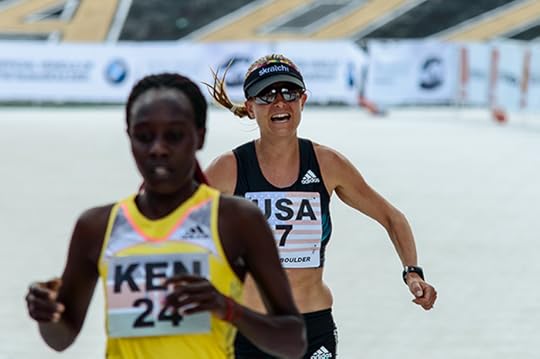
2016 Bolder Boulder 10K
Colorado resident Alisha Williams was the top American in the women's pro race, finishing eighth in 34:42. Photo: Peter N. Jones
View Larger Image
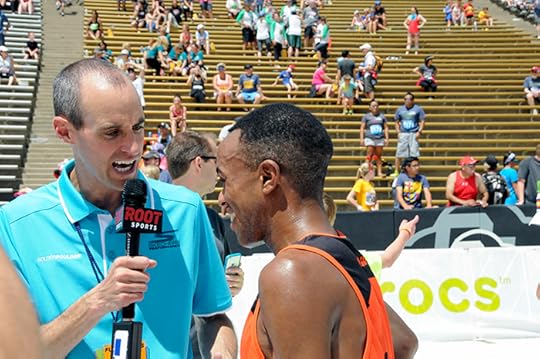
2016 Bolder Boulder 10K
Two-time U.S. Olympian Alan Culpepper interviewed winner Isaac Mukundi for the Root Sports broadcast of the race. Photo: Brian Metzler
View Larger Image
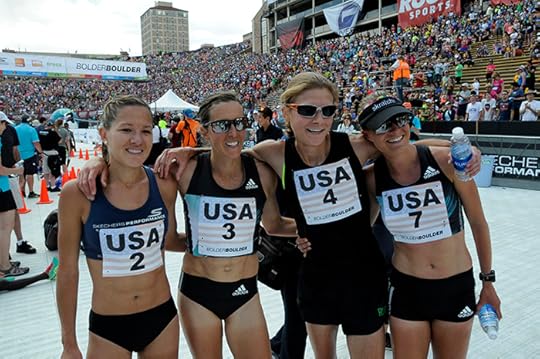
2016 Bolder Boulder 10K
American runners Tara Welling (10th), Brianne Nelson (13th), Lindsey Scherf (11th) and Alisha Williams (8th) celebrate after a strong showing in the women's elite race. Photo: Brian Metzler
View Larger Image
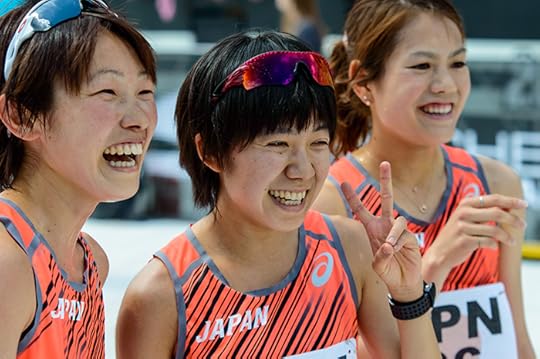
2016 Bolder Boulder 10K
The Japanese women's team placed second, led by a runner-up finish from Miyuki Uehara. Kenya won the women's team title, followed by Japan, Ethiopia and the USA Red team in the final team standings. Photo: Peter N. Jones
View Larger Image
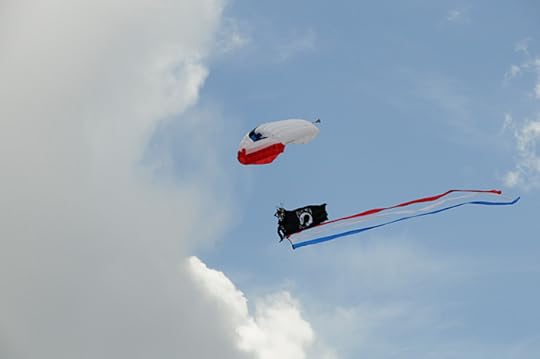
2016 Bolder Boulder 10K
After the races concluded, one of the country's largest Memorial Day celebrations began. Skydivers landed in the stadium, brining flags of all branches of the U.S. military, an MIA/POW flag and a giant American flag. Photo: Brian Metzler
View Larger Image
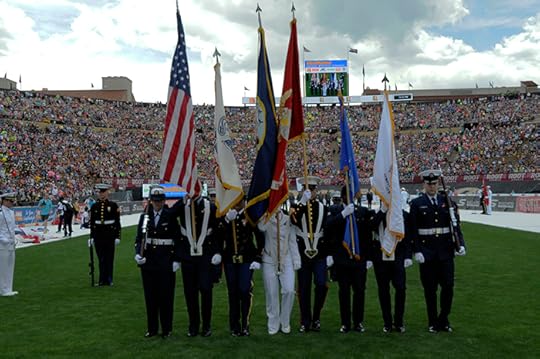
2016 Bolder Boulder 10K
More than 40,000 people in the stadium were treated to a military color guard presentation, an Air Force jet fly-over and a 21-gun salute to veterans. Photo: Brian Metzler
View Larger Image
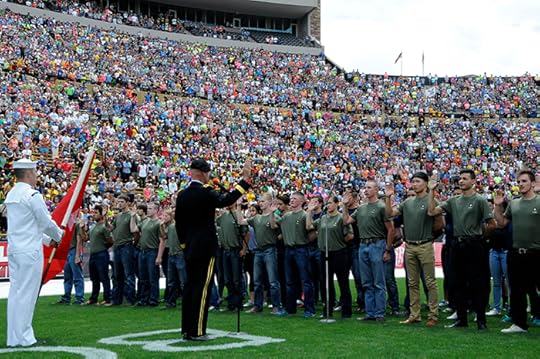
2016 Bolder Boulder 10K
Several dozen new enlistees took the oath to serve in the U.S. Armed Forces during a ceremony after the race. Photo: Brian Metzler
View Larger Image
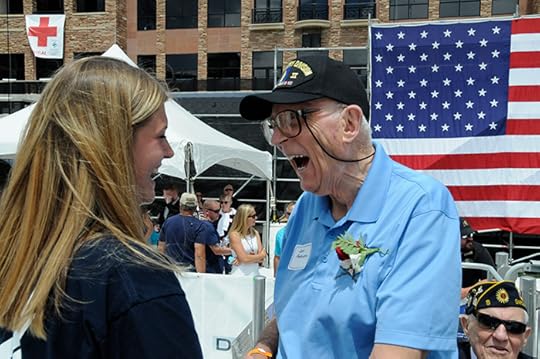
2016 Bolder Boulder 10K
After the ceremony, new enlistees had the opportunity to meet the race's honored veterans. Photo: Brian Metzler
Related Galleries
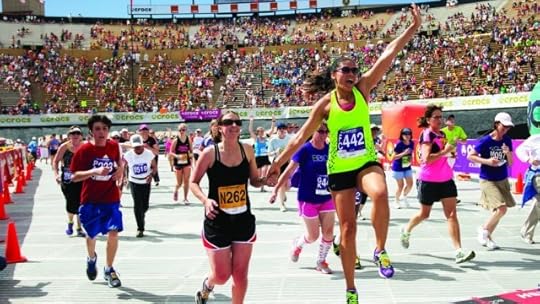
Why the Bolder Boulder 10K Should Be on Your Bucket List
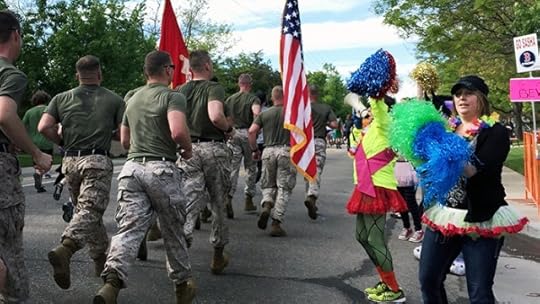
Photos: 30 Great Images from the 2015 Bolder Boulder 10K

More Galleries
The post Photos: More Than 50,000 Run the 2016 Bolder Boulder 10K appeared first on Competitor.com.
Ryan Hall's Blog
- Ryan Hall's profile
- 21 followers



